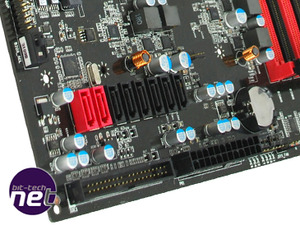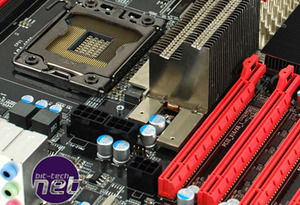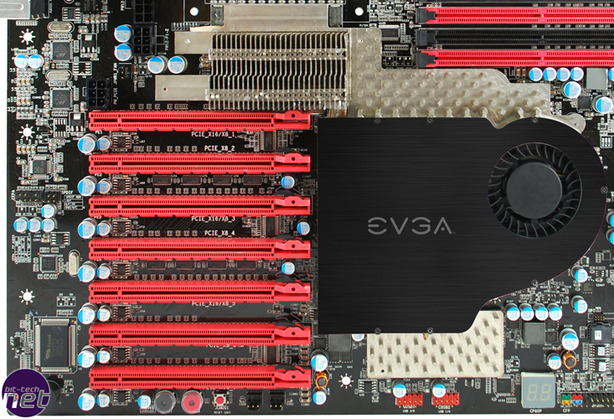
Up close and personal
Although detailed specs are not available right now, you can still tell quite a lot about the prototype W555 just from looking at it.For instance, we know that the seven 16x PCI-E 2.0 slots that take up nearly half of the surface area are powered by a combination of the Intel 5520 chipset and two nForce 200 controllers hidden underneath the massive black heatsink/fan.
Apparently the lanes are configured so that slots 1, 3, 5 and 7 each provide the full 16 lanes, or alternatively the first six slots each have 8 lanes and slot 7 has 16 lanes.
A side effect of using the nForce 200 controllers is that, unlike traditional Xeon workstation/server motherboards, the W555 will also be certified for both CrossFire and SLI.
However, given the dire state of both ATI and Nvidia's quad-GPU drivers, we really can't see much use for this capability, unless you buy a W555 just to try and get the fastest 3DMark score in the world. A far better use for the W555 would be as an all-in-one folding farm, running a combination of the bigadv clients on the CPUs in Linux and several GPU clients on whatever graphics cards you have to hand. This would yield a titanic number of points per day, as Folding@home, unlike CrossFire and SLI, scales efficiently across multiple GPUs. Just make sure to add your W555 system to the Custom PC/bit-tech folding team, number 35947.
We can also see that the
 W555 is equiped with eight SATA ports, allegedly six running at 3Gb/sec and the two red ports at 6GB/sec. Unfortunately, at this stage we don't which SATA controllers EVGA is planning on using on the final production model.
W555 is equiped with eight SATA ports, allegedly six running at 3Gb/sec and the two red ports at 6GB/sec. Unfortunately, at this stage we don't which SATA controllers EVGA is planning on using on the final production model.The real curiosity though is the IDE port lurking at the edge of the PCB. While your first reaction might be 'what on earth is an IDE port doing a dual-processor/multi-GPU motherboard launching in 2010?' it's not a completely daft choice.
This is because some extreme overclockers still favour IDE hard drives over SATA, as many benchmarks aren't affected by the speed of the drive, and IDE controllers are less sensitive to big overclocks than SATA controllers.
Those living in the real world will still want to stick on a SATA hard disk or SSD however.
With so many PCI-E slots on-board, EVGA has clearly put some thought into how to provide sufficient power to so many graphics cards.

Thus, in addition to the 24-pin ATX and two 8-pin EPS12V power sockets dotted around the PCB, the W555 also sports three 6-pin PCI-E power sockets. This is a far better choice than sticking a load of Molex connectors on, like early multi-GPU motherboards had.
However, we're not quite sure how strictly necessary all this effort is. This because one of our folding rigs has six GeForce 9600 GTs and an overclocked Core i7-920 and has been happily running 24/7 at full load for the last six months without a hitch. There's also a question of which PSU could possibly power such a combination, or it'll take jump-starting a second alongside to provide the necessary connectors.
That's about all we can say about the EVGA W555 for now - for any more info you'll have to wait a more weeks/months until the first press samples are shipped out. In the meantime, let us know your thoughts in the forums.

MSI MPG Velox 100R Chassis Review
October 14 2021 | 15:04









Want to comment? Please log in.